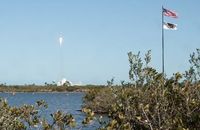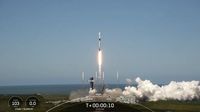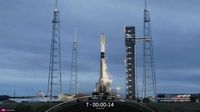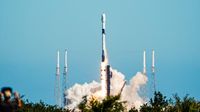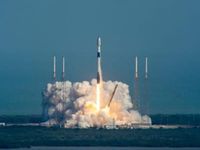SpaceX successfully launched its Starlink 12-25 mission on March 18, 2025, deploying 23 Starlink V2 Mini satellites to low Earth orbit (LEO) from Cape Canaveral Space Force Station at 3:57 p.m. EDT. The mission marks another step in SpaceX's efforts to enhance global internet connectivity through its growing satellite constellation.
The Falcon 9 rocket, which carried the satellites, had a smooth liftoff, aided by favorable weather conditions that were predicted by the 45th Weather Squadron, which had assessed a 95 percent chance of good weather for the launch. Winds were expected to be between 18 and 26 miles per hour, but posed only a moderate risk to operations, a manageable hurdle for the launch team.
SpaceX’s first stage booster, designated B1077, completed its 19th flight during this mission, successfully landing on the company’s droneship ‘A Shortfall of Gravitas’ in the Atlantic Ocean about eight minutes after liftoff. This marked the 102nd successful booster landing for that vessel and the 420th successful booster landing overall for SpaceX.
Among the 23 deployed satellites, 13 possess Direct to Cell (DTC) capabilities, aimed at improving connectivity for mobile users. As of March 16, 2025, SpaceX had deployed a total of 557 DTC satellites into orbit and now has 543 remaining functional in space, as reported by renowned orbital tracker and astronomer Jonathan McDowell.
This launch was significant not only for the advancements in satellite technology but also in the context of ongoing missions within SpaceX’s broader operational goals. At the same time, the Crew-9 mission made headlines by returning four astronauts from the International Space Station (ISS), who splashed down off Florida's coast at 5:57 p.m. EDT on the same day. NASA's astronauts Butch Wilmore and Suni Williams, along with their crewmates, returned via the Crew Dragon capsule named Freedom.
SpaceX has consistently proven its capacity for simultaneous operations, and the successful deployment of satellites alongside the safe return of astronauts exemplifies its robust operational framework. As of now, SpaceX operates nearly 7,100 Starlink satellites in low Earth orbit, the largest constellation ever assembled.
The launch not only serves a technological purpose but also comes amid a season of rapid developments in space exploration, underscored by SpaceX's recent achievements, such as executing three Falcon 9 launches within a 13-hour window just days before this mission.
With ambitions to expand satellite broadband access worldwide, the direct-to-cell capabilities of the newly launched satellites indicate a concerted effort to bridge the digital divide, particularly in underserved areas. The positive trajectory of SpaceX's satellite deployment strategy is reflective of the increasing demand for internet access and connectivity globally.
SpaceX’s CEO Elon Musk has emphasized the importance of these missions for ensuring global connectivity, which he believes is crucial as internet usage continues to expand dramatically.
As SpaceX prepares for future missions, the company remains committed to its vision of a seamless and expansive internet service network. With plans to launch more satellites, including those equipped with innovative capabilities, SpaceX seeks to redefine the global communications landscape continuously.
This launch and operation cycle underscores SpaceX's dedication not only to space exploration but also to addressing global connectivity challenges through its state-of-the-art technology.
Overall, the successful execution of the Starlink 12-25 mission reflects SpaceX's enduring vision as a leader in satellite technology and its commitment to expanding internet access across the world.
